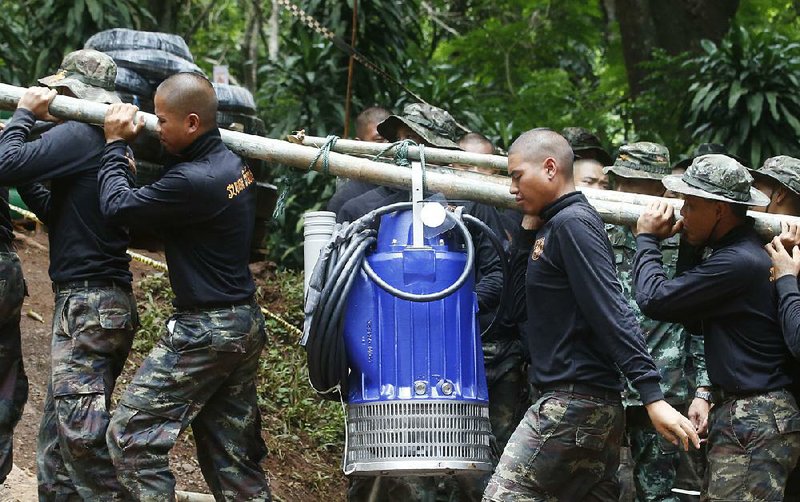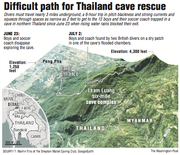MAE SAI, Thailand -- Thai officials were still trying Friday to work out an extraction plan for the young soccer team and their coach trapped for two weeks in a water-filled cave, stoking fears that all available options remain too risky.
Officials said they were rethinking strategies after a diver died while trying to set air tanks along a route through the vast cavern complex. By late Friday, they had still failed to agree to a rescue method and acknowledged that all remain risky and imperfect.
"We are trying to set a plan," said Chiang Rai Gov. Narongsak Osotthanakorn. "If the risk is minimum to get them out, then, maybe, we will try."
Today marks two weeks since the dozen young teammates and their coach became stranded deep in the cave after flash floods from heavy rains blocked their exit. Saving them now poses challenges for a growing team of rescuers from around the world.
"When we found the boys, we thought that the boys would be able to survive in there for a long time," Thai navy SEAL commander Rear Adm. Arpakorn Yookongkaew told reporters Friday. "But now, things have changed. We have limited time. We have to work hard."
The oxygen level in the boys' cavern is about 15 percent and decreasing, he said, which is cause for concern: Below 16 percent can cause hypoxia, which in extreme cases can be fatal.
In a possible new bid to avoid the waters, engineers working for entrepreneur Elon Musk will be dispatched to Thailand. In a series of tweets, Musk said his tunneling firm Boring Co. and others will look for potential ways to reach the underground chamber in northern Thailand.
Drilling into the cave and extracting the boys from above has been suggested, but Narongsak said only 18 of the 100 holes they have located are potentially viable for that.
The boys, he added, "cannot dive at this time" and are not ready to make the almost six-hour journey out of the cave. At the same time, officials are concerned about the weather, with heavy rains forecast within days that could flood the cave again and render their efforts to pump out water futile.
"We would like to take the minimum risk possible," he said. "But we can't wait for the rain.
One American cave diver, an Air Force rescue specialist who is part of a team sent to help from Okinawa, Japan, said that getting the boys out now would require shepherding them through underwater passageways as much as a quarter-mile long without air pockets above.
The cave complex, which has never been fully mapped, has many different formations, said the American, who could not be identified by name for security reasons.
It is not a single river running through the cave, he said, and not all of the waterways appear to be directly connected. Pumping water from spots near the cave entrance does not necessarily reduce the level in more distant parts of the network, like where the boys and their coach are.
Underwater, everything is 10 times more difficult than it would be above ground: communicating, solving complex technical problems, providing emergency care, just moving around, he said.
The terrain varies from one area to the next -- from sandy bottom to deep mud to boulders the size of a house. In one place, waters converge to create occasional geysers.
Currents can flow quickly, especially when it has been raining outside and the water level in the cave rises.
In some places, he said, one can see waterlines high on the walls of the cave -- much higher than today's levels -- showing how high the water has risen in the past.
Some passages are narrow -- as small as 2-feet-by-2½-feet, said Ben Reymenants, a Belgian cave diver. But the circumstances compelled him to explore the cave in a way that was risky even for a professional who had dived in dangerous spots around the globe, he said.
"Normally, I'd just turn around," he said, "but then normally I don't have 12 boys, and their entire lives, as an endpoint."
Guiding the boys out through a dive has been raised as the most likely possibility, but a retired Thai navy SEAL preparing the boys for their dive ran out of oxygen early Friday morning and died shortly after.
Speaking at a news conference, a commander of the Thai navy SEAL group said the retired SEAL was placing compressed air tanks along an exit route to assist the boys in their escape from the cave when his own oxygen ran out. He was found unconscious about 1 a.m. Friday. Efforts to revive him were unsuccessful, and he was later transferred to a hospital where he was pronounced dead on arrival.
"It is sad news," Pasakorn Boonyalak, deputy governor of Chiang Rai province, said at the news conference. "His job was to deliver oxygen, but he did not have enough on his way back."
The fatality raises fears that a rescue mission could be fraught and even deadly for the boys.
The diver, identified as Saman Kunam, 38, was about half a mile from where the 12 young soccer players and their coach have been trapped since June 23.
Information for this article was contributed by Shibani Mahtani of The Washington Post; and by Richard C. Paddock, Muktita Suhartono and Mike Ives of The New York Times.
A Section on 07/07/2018

